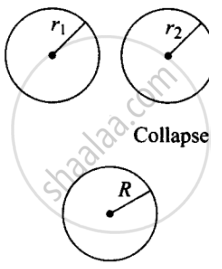Advertisements
Advertisements
प्रश्न
Two mercury droplets of radii 0.1 cm. and 0.2 cm. collapse into one single drop. What amount of energy is released? The surface tension of mercury T = 435.5 × 10–3 Nm–1.
उत्तर
When two drops form a bigger drop, volume remains conserved.

According to the problem, there is two mercury droplets of different radii collapse into one single drop.
Radius of smaller drop = r1 = 0.1 cm = 10–3 m
Radius of bigger drop = r2 = 0.2 cm = 2 × 10–3 m
Surface tension (T) = 435.5 × 10–3 N/m
Let V1 and V2 be the volumes of these two mercury droplets and the volume of big drops formed by collapsing is V.
The volume of a big drop = Volume of small droplets
`V = V_1 + V_2`
`4/3 πR^3 = 4/3 πr_1^3 + 4/3 πr_2^3`
or `R^3 = r_1^3 + r_2^3`
= (0.1)3 + (0.2)3
= 0.001 + 0.008
= 0.009
or R = 0.21 cm = 2 × 10–3 m
∴ Decrease in surface area,
ΔA = `4πR^2 - (4πr_1^2 + 4πr_2^2)`
= `4π[R^2 - (r_1^2 + r_2^2)]`
Energy released,
`E = T xx ΔA`
= `T xx 4π[R^2 - (r_1^2 + r_2^2)]`
= `435.5 xx 10^-3 xx 4 xx 3.14[(2.1 xx 10^-3)^2 - (1 xx 10^-6 + 4 xx 10^-6)]`
= `435.5 xx 4 xx 3.14[4.41 - 5] xx 10^-6 xx 10^-3`
= – 32.23 × 10–7 ......(Negative sign shows absorption)
Therefore, 3.22 × K–6 J energy will be absorbed. So, the surface area of the water decreases means the surface area of bigger drop is less than the sum of surface area of two smaller drops.
APPEARS IN
संबंधित प्रश्न
The surface tension of water at 0°C is 75.5 dyne/cm. Calculate surface tension of water at 25°C.
(α for water = 2.7×10-3/°C)
Explain why Water on a clean glass surface tends to spread out while mercury on the same surface tends to form drops. (Put differently, water wets glass while mercury does not.)
A barometer is constructed with its tube having radius 1.0 mm. Assume that the surface of mercury in the tube is spherical in shape. If the atmospheric pressure is equal to 76 cm of mercury, what will be the height raised in the barometer tube? The contact angle of mercury with glass = 135° and surface tension of mercury = 0.465 N m−1. Density of mercury = 13600 kg m−3.
A capillary tube of radius 1 mm is kept vertical with the lower end in water. (a) Find the height of water raised in the capillary. (b) If the length of the capillary tube is half the answer of part , find the angle θ made by the water surface in the capillary with the wall.
Explain the phenomena of surface tension on the basis of molecular theory.
A u-tube is made up of capillaries of bore 1 mm and 2 mm respectively. The tube is held vertically and partially filled with a liquid of surface tension 49 dyne/cm and zero angles of contact. Calculate the density of the liquid, if the difference in the levels of the meniscus is 1.25 cm. take g = 980 cm/s2
A capillary of diameter d mm is dipped in water such that the water rises to a height of 30 mm. If the radius of the capillary is made `(2/3)` of its previous value, then compute the height up to which water will rise in the new capillary?
Water rises upto a height h in a capillary tube on the surface of the earth. The value of h will increase, if the experimental setup is kept in [g = acceleration due to gravity]
When an air bubble of radius r rises from the bottom to the surface of a lake, its radius becomes `(5r)/4`. Taking the atmospheric pressure to be equal to the 10 m height of the water column, the depth of the lake would approximately be ______.
(ignore the surface tension and the effect of temperature)
When one end of the capillary is dipped in water, the height of water column is 'h'. The upward force of 105 dyne due to surface tension is balanced by the force due to the weight of water column. The inner circumference of capillary is ______.
(Surface tension of water = 7 × 10-2 N/m)
